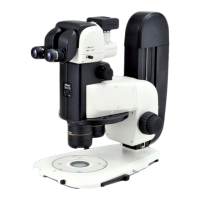Chapter 7 Specific Operations
78
9
Shifting a Sample
To view another part of a sample during microscopy, use the following procedure to shift the sample.
9.1
Sliding the Stage Plate
Move the specimen by sliding the stage plate of the base or stand with the sliding mechanism.
The stage plate can be smoothly and finely moved within the approximately 3 mm range by loosening the stage plate fixing
screw.
This mechanism is useful for positioning, especially for high-magnification observation.
Securely fix the stage plate in place using the fixing screw when this mechanism does not need to be used.
There are three types of the bases that have the sliding mechanism: P2-DBL and P2-DBF.
The stands P-DSL32 and P-DSF32, which can be used in combination with the SMZ18 Zooming Body, have this mechanism.
9.2
Shifting the Stage in the X and Y Directions (P-SXY64 XY Stage)
Turn the XY shift knob of the P-SXY64 XY Stage mounted instead
of the stage plate to shift the sample on the glass plate and
change the part to be observed.
XY stroke of the stage with the X/Y shift knob and stroke
per rotation of the knob
X: 150 mm; 37.5 mm per rotation
Y: 100 mm; 24.1 mm per rotation
Restriction
If the P-SXY64 XY Stage is mounted on the P-PS32 Plain Stand,
the movement of the stroke in the Y direction is restricted.
* Also see Chapter 8, “5.7 P-SXY64 XY Stage.”
Shift using the P-SXY64 XY Stage
9.3
Using the Sliding Stage
Remove the stage plate from the base or the stand and attach the C-SSL DIA Sliding Stage or C-TRS Tilting Stage in place
so that the sample can be tilted or moved slightly.

